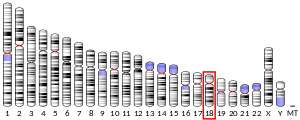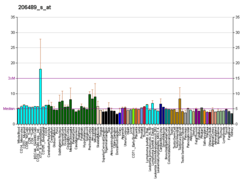DLGAP1
Disks large-associated protein 1 (DAP-1), also known as guanylate kinase-associated protein (GKAP), is a protein that in humans is encoded by the DLGAP1 gene. DAP-1 is known to be highly enriched in synaptosomal preparations of the brain, and present in the post-synaptic density.[5]
Function
This gene encodes the protein called guanylate kinase-associated protein (GKAP). GKAP binds to the SHANK and PSD-95 proteins, facilitating the assembly of the post-synaptic density of neurons.[6] Dlgap1 has five 14-amino-acid repeats and three Pro-rich portions.
Interactions
DLGAP1 has been shown to interact with:
The interaction with PSD95 and S-SCAM is mediated by the GUK domain[13] and it has been hypothesized that this might mean it can also interact with other GUK containing proteins.
References
- 1 2 3 GRCh38: Ensembl release 89: ENSG00000170579 - Ensembl, May 2017
- 1 2 3 GRCm38: Ensembl release 89: ENSMUSG00000003279 - Ensembl, May 2017
- ↑ "Human PubMed Reference:".
- ↑ "Mouse PubMed Reference:".
- ↑ "Entrez Gene: DLGAP1 discs, large (Drosophila) homolog-associated protein 1".
- ↑ Hines RM, El-Husseini A (2006). "Mechanisms that regulate neuronal protein clustering at the synapse". In El-Husseini A, Dityatev A. Molecular mechanisms of synaptogenesis. Berlin: Springer. pp. 72–75. ISBN 0-387-32560-3.
- 1 2 Takeuchi M, Hata Y, Hirao K, Toyoda A, Irie M, Takai Y (May 1997). "SAPAPs. A family of PSD-95/SAP90-associated proteins localized at postsynaptic density". J. Biol. Chem. 272 (18): 11943–51. doi:10.1074/jbc.272.18.11943. PMID 9115257.
- 1 2 Satoh K, Yanai H, Senda T, Kohu K, Nakamura T, Okumura N, Matsumine A, Kobayashi S, Toyoshima K, Akiyama T (June 1997). "DAP-1, a novel protein that interacts with the guanylate kinase-like domains of hDLG and PSD-95". Genes Cells. 2 (6): 415–24. doi:10.1046/j.1365-2443.1997.1310329.x. PMID 9286858.
- 1 2 Wu H, Reissner C, Kuhlendahl S, Coblentz B, Reuver S, Kindler S, Gundelfinger ED, Garner CC (November 2000). "Intramolecular interactions regulate SAP97 binding to GKAP". EMBO J. 19 (21): 5740–51. doi:10.1093/emboj/19.21.5740. PMC 305801. PMID 11060025.
- 1 2 Kim E, Naisbitt S, Hsueh YP, Rao A, Rothschild A, Craig AM, Sheng M (February 1997). "GKAP, a novel synaptic protein that interacts with the guanylate kinase-like domain of the PSD-95/SAP90 family of channel clustering molecules". J. Cell Biol. 136 (3): 669–78. doi:10.1083/jcb.136.3.669. PMC 2134290. PMID 9024696.
- 1 2 3 4 Naisbitt S, Valtschanoff J, Allison DW, Sala C, Kim E, Craig AM, Weinberg RJ, Sheng M (June 2000). "Interaction of the postsynaptic density-95/guanylate kinase domain-associated protein complex with a light chain of myosin-V and dynein". J. Neurosci. 20 (12): 4524–34. PMID 10844022.
- 1 2 Boeckers TM, Winter C, Smalla KH, Kreutz MR, Bockmann J, Seidenbecher C, Garner CC, Gundelfinger ED (October 1999). "Proline-rich synapse-associated proteins ProSAP1 and ProSAP2 interact with synaptic proteins of the SAPAP/GKAP family". Biochem. Biophys. Res. Commun. 264 (1): 247–52. doi:10.1006/bbrc.1999.1489. PMID 10527873.
- ↑ Hirao K, Hata Y, Ide N, Takeuchi M, Irie M, Yao I, et al. (1998). "A novel multiple PDZ domain-containing molecule interacting with N-methyl-D-aspartate receptors and neuronal cell adhesion proteins". J Biol Chem. 273 (33): 21105–10. doi:10.1074/jbc.273.33.21105. PMID 9694864.
Further reading
- Kim E, Naisbitt S, Hsueh YP, et al. (1997). "GKAP, a novel synaptic protein that interacts with the guanylate kinase-like domain of the PSD-95/SAP90 family of channel clustering molecules". J. Cell Biol. 136 (3): 669–78. doi:10.1083/jcb.136.3.669. PMC 2134290. PMID 9024696.
- Takeuchi M, Hata Y, Hirao K, et al. (1997). "SAPAPs. A family of PSD-95/SAP90-associated proteins localized at postsynaptic density". J. Biol. Chem. 272 (18): 11943–51. doi:10.1074/jbc.272.18.11943. PMID 9115257.
- Naisbitt S, Kim E, Weinberg RJ, et al. (1997). "Characterization of guanylate kinase-associated protein, a postsynaptic density protein at excitatory synapses that interacts directly with postsynaptic density-95/synapse-associated protein 90". J. Neurosci. 17 (15): 5687–96. PMID 9221768.
- Satoh K, Yanai H, Senda T, et al. (1997). "DAP-1, a novel protein that interacts with the guanylate kinase-like domains of hDLG and PSD-95". Genes Cells. 2 (6): 415–24. doi:10.1046/j.1365-2443.1997.1310329.x. PMID 9286858.
- Hirao K, Hata Y, Ide N, et al. (1998). "A novel multiple PDZ domain-containing molecule interacting with N-methyl-D-aspartate receptors and neuronal cell adhesion proteins". J. Biol. Chem. 273 (33): 21105–10. doi:10.1074/jbc.273.33.21105. PMID 9694864.
- Deguchi M, Hata Y, Takeuchi M, et al. (1998). "BEGAIN (brain-enriched guanylate kinase-associated protein), a novel neuronal PSD-95/SAP90-binding protein". J. Biol. Chem. 273 (41): 26269–72. doi:10.1074/jbc.273.41.26269. PMID 9756850.
- Kawabe H, Hata Y, Takeuchi M, et al. (1999). "nArgBP2, a novel neural member of ponsin/ArgBP2/vinexin family that interacts with synapse-associated protein 90/postsynaptic density-95-associated protein (SAPAP)". J. Biol. Chem. 274 (43): 30914–8. doi:10.1074/jbc.274.43.30914. PMID 10521485.
- Boeckers TM, Winter C, Smalla KH, et al. (1999). "Proline-rich synapse-associated proteins ProSAP1 and ProSAP2 interact with synaptic proteins of the SAPAP/GKAP family". Biochem. Biophys. Res. Commun. 264 (1): 247–52. doi:10.1006/bbrc.1999.1489. PMID 10527873.
- Naisbitt S, Valtschanoff J, Allison DW, et al. (2000). "Interaction of the postsynaptic density-95/guanylate kinase domain-associated protein complex with a light chain of myosin-V and dynein". J. Neurosci. 20 (12): 4524–34. PMID 10844022.
- Wu H, Reissner C, Kuhlendahl S, et al. (2000). "Intramolecular interactions regulate SAP97 binding to GKAP". EMBO J. 19 (21): 5740–51. doi:10.1093/emboj/19.21.5740. PMC 305801. PMID 11060025.
- Haraguchi K, Satoh K, Yanai H, et al. (2001). "The hDLG-associated protein DAP interacts with dynein light chain and neuronal nitric oxide synthase". Genes Cells. 5 (11): 905–911. doi:10.1046/j.1365-2443.2000.00374.x. PMID 11122378.
- Lo KW, Naisbitt S, Fan JS, et al. (2001). "The 8-kDa dynein light chain binds to its targets via a conserved (K/R)XTQT motif". J. Biol. Chem. 276 (17): 14059–66. doi:10.1074/jbc.M010320200. PMID 11148209.
- Strausberg RL, Feingold EA, Grouse LH, et al. (2003). "Generation and initial analysis of more than 15,000 full-length human and mouse cDNA sequences". Proc. Natl. Acad. Sci. U.S.A. 99 (26): 16899–903. doi:10.1073/pnas.242603899. PMC 139241. PMID 12477932.
- Im YJ, Lee JH, Park SH, et al. (2004). "Crystal structure of the Shank PDZ-ligand complex reveals a class I PDZ interaction and a novel PDZ-PDZ dimerization". J. Biol. Chem. 278 (48): 48099–104. doi:10.1074/jbc.M306919200. PMID 12954649.
- Ballif BA, Villén J, Beausoleil SA, et al. (2005). "Phosphoproteomic analysis of the developing mouse brain". Mol. Cell. Proteomics. 3 (11): 1093–101. doi:10.1074/mcp.M400085-MCP200. PMID 15345747.
- Suzuki T, Li W, Zhang JP, et al. (2005). "A novel scaffold protein, TANC, possibly a rat homolog of Drosophila rolling pebbles (rols), forms a multiprotein complex with various postsynaptic density proteins". Eur. J. Neurosci. 21 (2): 339–50. doi:10.1111/j.1460-9568.2005.03856.x. PMID 15673434.
- Sabio G, Arthur JS, Kuma Y, et al. (2005). "p38gamma regulates the localisation of SAP97 in the cytoskeleton by modulating its interaction with GKAP". EMBO J. 24 (6): 1134–45. doi:10.1038/sj.emboj.7600578. PMC 556394. PMID 15729360.





